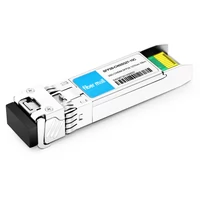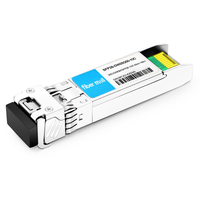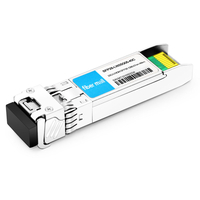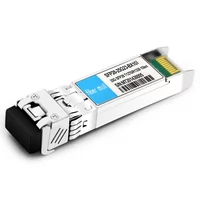As 5G technology is accelerating its large-scale commercial deployment, the number of 5G communication base stations built up by operators is expected to increase exponentially in the next few years. 5G fronthaul is the essential part of 5G network transmission. The fronthaul technology solution based on wavelength division multiplexing (WDM) has become the focus of the industry. This article will present and evaluate 5G fronthaul demand for 25G WDM technology, typical types of 5G fronthaul WDM technical solutions, 25G LAN-WDM technical solutions, and its standardization.
Table of Contents
Toggle1. What is Fronthaul in 5G?
5G network consists of the access network(AN), bearer network, and Core Network(CN). The access network is generally a radio access network (RAN), which is mainly composed of communication base stations. Unlike 4G technology, 5G is not made up of BBU(Base Band Unit)、RRU(Remote Radio Unit), or antenna; instead, it is reconfigured as the following three functional entities: CU (Centralized Unit, Distribute Unit), DU (Distribute Unit, Distribute Unit), and AAU(Active Antenna Unit, Distributed Unit). The original 4G RRU and antenna are combined into AAU, and the BBU is separated into CU and DU. The DU is embedded in the AAU, and one CU can be connected to multiple DUs.
Only two parts exist in the 4G network connecting: front haul and backhaul. While in 5G networks, it has evolved into three parts. The AAU connecting DU is called 5G fronthaul, the middle haul refers to the DU connection with CU, and the backhaul is the communication bearer between the CU and the core network.
2. What is WDM?
The concept of WDM(meaning Wavelength Division Multiplexing) is to use multiple light sources operating at different wavelengths to transmit a few independent information streams simultaneously over the same optical fiber.
In the early days, the wavelength interval would be controlled within dozens of nm due to technical limits. This kind of dispersed wavelength division multiplexing is called sparse wavelength division multiplexing, which is CWDM (Coarse WDM). As the technology advanced, the wavelength interval became shorter. When it reached the level of a few nm, it evolves into a compact WDM called Dense Wavelength Division Multiplexing, or DWDM (Dense WDM). LAN WDM (or LWDM)is a kind of WDM between CWDM and DWDM. Its channel space is about 6.4nm(800G), while CWDM channel space is 20nm and DWDM channel space is 0.8nm(100G).
3. Different Technology Solutions to 5G Fronthaul
● Direct Optical Fiber Connectivity
As one of the main connectivity solutions for 5G fronthaul, direct optical fiber connecting has two networking methods: one is over unidirectional single fiber; the other is over bi-directional single fiber (BIDI). However, optical fiber resources can hardly meet the demand for direct fiber network connection in urban areas where 5G coverage is deployed in priority. Thus, in order to function normally under the CRAN mode, the AAU has to combine with other technology solutions, one of which is multiplexing multiple wavelengths on the same single fiber to greatly reduce the utilization of fiber resources in the fronthaul.
● 25G WDM technology-An Urge for 5G Fronthaul
From the technical point of view, 5G features high transmission speed(from 25Gbit/s to 100Gbit/s even 200G), low latency with 1 millisecond, and high clock-synchronization accuracy. Since a large number of AAUs in the 5G fronthaul are required, the cost of accessing the bearer network will increase significantly.
The 5G fronthaul network will widely adopt the eCPRI interface, which requires a data speed of 25G in the configuration of 100MHz spectrum, 64T/64R antenna, and 16 downstream/upstream 8 streams. Multiple 25G Ecpri interfaces need to be deployed in 5G fronthaul when the wireless spectrum is broader.
There are many solutions for 25G WDM technology that can be applied to 5G fronthaul, including DWDM, CWDM, and LAN WDM, as shown in Figure 1. The rest of this article will present and analyze these solutions respectively.

◮ Figure1 Technology Solutions to 5G Fronthaul
- 4. Mobile Fronthaul Network Structure Based on 25G WDM
According to the differences in equipment, mobile fronthaul optical network connectivity structure based on WDM technology can be divided into three types: active WDM connectivity, semi-active WDM connectivity, and passive WDM connectivity. Figure 2 shows the three types of structure.
● Active WDM Connectivity
For the type of fully active WDM network, its central office also called ATU-C (ADSLTransceiverUnit-Centroloffice) and remote data station are both active equipment with clear professional interfaces and integrated multi-traffic bearer access. But the power supply and installation of remote equipment have to be considered.
● Semi-Active WDM Connectivity
For the semi-active WDM network structure, its central office is active equipment while the remote data station is simplified as WDM optical transceiver and passive multiplexer & demultiplexer. This type needs to be confirmed so that the WDM optical module can be installed on the data transport equipment.
● Passive WDM Connectivity
Central office and remote data station for the third type are both with passive equipment, also being simplified as WDM optical transceiver and passive multiplexer & demultiplexer, which need to been confirmed their installations on data transport equipment. Therefore, from the perspective of network construction, operation, and maintenance, the first 2 types of mobile fronthaul Network structure are preferred over the third one in reality.

◮ Figure 2 Mobile Fronthaul Network Structure Based on WDM
- 5. 5G Fronthaul solution based on 25G DWDM
25G DWDM technology can be applied in fixed wavelength and tunable wavelength according to the working wavelength of the laser, as shown in Figure 3.
● Segments of 25G DWDM Technology
DWDM technology used in tunable wavelength has been widely utilized in the optical network of 10G, 40G, and 100G. But it is still struggling to meet the demand on massive and cost-sensitive application situations of the metro access layer. There are many technical solutions for realizing tunable lasers, including DFB array, DBR, DS DBR, MG-Y, SG DBR, VCSEL, ECL, silicon optical micro-ring cavity, and V-shaped coupling cavity, etc., all controlled by temperature, current, and mechanics.
Cost-effective optical modules using DWDM technology with tunable wavelength include those with fully tunable broadband C-band and partly tunable narrowband C-band. Nevertheless, the latter enjoys a more obvious cost advantage over the former and some companies specializing in the optical transceiver and optical component have launched their related products series, which is available on the current market.

◮ Figure 3 Segments of 25G DWDM Technology
● G.698.4/PAB-WDM-An Example of DWDM
A good example of such optical modules based on DWDM technology with tunable wavelength is G.698.4(originally G.metro)solution, also called PAB-WDM,Port-Agnostic Bidirectional WDM technology option.
Its biggest advantage lies in port-independent characteristics, the ability of the module’s end-end wavelength self-adaptation (without configuration), and adaptive data rate, making it easy to control and maintain. By adopting the optical top layer modulation technology in WDM networks, this G.698.4 h has achieved the message control of head-end equipment (HEE) and the tail-end equipment (TEE) as well as the signal channel (HTMC/THMC). It is used to adapt and control the wavelength rate of the remote tunable optical module to realize a simple and effective OAM mechanism at the system level. Please refer to figure 4 as follows.

◮ Figure 4 G.698.4/PAB-WDM Fronthaul Solution
In the ITU-T SG15 conference held in Geneva in July 2019, operators including China Unicom, China Telecom, Deutsche Telekom, Telecom Italia, and KDDI brought up their urgent demand on 5G fronthaul based on 25G DWDM technology. Meanwhile, companies such as China Unicom and Ericsson submitted a related detailed test report and ITU-T SG15 initiated the development project of the G.698.4 standard v2.0 version (25G data rate).
- 6. Technology Solution Based on 25G CWDM
● Technical Analysis of 25G CWDM
With the large-scale deployment of 100G CWDM4 optical modules in data centers, there are various applications of lasers that meet the standard of data center environments and commercial-grade CWDM4. Fiber optic transceivers at the wavelength of 1271nm, 1291nm, 1311nm, and 1331nm have come to their mature developing stage. If CWDM laser operates without TEC temperature control, there tends to be a large temperature drift (typical value 0.1nm/°C), making it difficult to meet the standard requirements of 13nm (±6.5nm) wavelength accuracy. The industry is working out a solution to ensure the stability of the center wavelength considering DML-based auxiliary heaters or TEC temperature control. Yet, using a heater or TEC will increase the cost of the CWDM solution.
For longer wavelengths (1351nm, 1371nm, etc.), DML lasers have the problem of dispersion limit, and the cost of dispersion is relatively high, resulting in an insufficient power budget for 10km fiber transmission. Some think about solving this problem by using EML or APD. Likewise, CWDM wavelength over 1371nm has no alternative but EML due to the dispersion limit. The CWDM solution that adopts the EML/APD and that increases the wavelength stability by TEC-assisted control are actually not cost-effective as people expect. In terms of network maintenance, using CWDM optical modules for 5G fronthaul cannot achieve effective management of remote optical modules. In addition, there may be a series of problems such as difficulties in wavelength identification, complicated management, and inconvenient equipment maintenance.
● Standardization of 25G CWDM
According to ITU-T G.694.2 standard, the CWDM wavelength is from 1271nm to 1611nm, with a wavelength interval of 20nm, and a total of 18 wavelengths. However, the 25G CWDM application code specified by the ITU-T G.695 standard has a maximum number of channels of 4, using 4 wavelengths of 1271nm, 1291nm, 1311nm, and 1331nm; the center wavelength deviation range is ±6.5nm, with a 2km working distance.
Figure 5 shows the current 5G fronthaul solution based on 25G CWDM technology. It is noted that problems such as insufficient power budget caused by industrial operating temperature and dispersion penalty for outdoor applications have not been solved yet. Thus, risks have to be taken if it is deployed widely.

◮ Figure 5 5G Fronthaul Based on 25G CWDM
7. Technology Solution based on 25G LAN-WDM
● 25G LAN-WDM Technology
LAN-WDM wavelength laser works in the O band with small dispersion. It can meet the requirements of industrial applications by adopting TEC temperature control. With the large-scale deployment of 100G LR4 optical modules in data centers and carrier networks, commercial-grade LAN-WDM4 lasers have a wider range of applications, mainly in the four wavelengths of 1295nm, 1300nm, 1304nm, and 1309nm. The corresponding DML industry chain is relatively more mature than other wavelengths DML. At present, diverse wavelength schemes for LAN-WDM fronthaul applications have sprung up. In addition to the 4-wave and 8-wave standards specified by ITU and IEEE, there are also different wavelength plans in the industry. The commonly used 6-wavelength scheme is the 4 wavelengths of LR4, plus two wavelengths of 1286nm and 1291nm.
Some also suggest that the channel spacing be reduced from 800GHz to 400GHz in order to obtain more usable wavelengths, but there has been no standardization for this so far. When the 25G LAN-WDM optical module is used for 5G fronthaul, the management message channel can be formed through the optical layer top adjustment mode specified by the G.698.4 standard to realize the management of the remote optical module. However, the LAN-WDM solution using a fixed wavelength laser has difficulties in wavelength identification, complicated management, and inconvenient maintenance even if the remote management of the top adjustment mode is adopted.
● Standardization of 25G LAN-WDM
LAN-WDM interfaces including 100G LR4, 200G LR4, and 400GLR8 are also stipulated in IEEE 802.3 standardization. In the following chart, you can check out the standardized LAN-WDM wavelength at present.
|
Channel |
Center Frequency(THz) |
Center Wavelength(nm) |
Wavelength Range |
IEEE 802.3 |
ITU-T G.959.1 |
|||
|
400G LR8 |
200G LR4 |
100G LR4 |
100G |
400G |
||||
|
L0 |
235.4 |
1273.54 |
1272.55-1274.54 |
√ |
|
|
|
√ |
|
L1 |
234.6 |
1277.89 |
1276.89-1278.89 |
√ |
|
|
|
√ |
|
L2 |
233.8 |
1282.26 |
1281.25-1283.27 |
√ |
|
|
|
√ |
|
L3 |
233 |
1286.66 |
1285.65-1287.68 |
√ |
|
|
|
√ |
|
L4 |
231.4 |
1295.56 |
1294.53-1296.59 |
√ |
√ |
√ |
√ |
√ |
|
L5 |
230.6 |
1300.05 |
1299.02-1301.09 |
√ |
√ |
√ |
√ |
√ |
|
L6 |
229.8 |
1304.58 |
1303.54-1305.63 |
√ |
√ |
√ |
√ |
√ |
|
L7 |
229 |
1309.14 |
1308.09-1310.19 |
√ |
√ |
√ |
√ |
√ |
◮ LAN-WDM Wavelength Standard
The ITU-T G.959.1 standard stipulates the 4-channel 25G LAN-WDM technology to apply wavelengths of 1295nm, 1300nm, 1304nm, and 1309nm respectively, and the channel spacing is 800GHz. At the same time, the 8-channel 50G LAN-WDM technology is also specified. The center wavelength of the first 4 waves is the same as that of 25G LAN-WDM.
Conclusion
Technology solutions for the 5G network fronthaul are starting the real race to offer the full functionality of 5G at a massive scale. Based on the analysis above, it is suggested that optic single-fiber bidirectional solutions be preferred in areas where optical fiber resources are insufficient.
Furthermore, the large scale of the 5G fronthaul network and the high cost in construction, as well as the maintenance of massive access layer equipment/optical modules, would challenge 5G operators and service providers to some extent. If the remaining fiber resources are in shortage, especially in dense urban areas with large-scale intensive BBU, WDM technology will be the first option to relieve the lack of fiber in the access layer of the metropolitan city thus reducing network construction costs.
Related Products:
-
 SFP28-CW25G27-10C 25G CWDM SFP28 1270nm 10km LC SMF DDM Transceiver Module
$50.00
SFP28-CW25G27-10C 25G CWDM SFP28 1270nm 10km LC SMF DDM Transceiver Module
$50.00
-
 SFP28-DW25G50-10C 25G DWDM SFP28 C50 100GHz 1537.40nm 10km LC SMF DDM Transceiver Module
$265.00
SFP28-DW25G50-10C 25G DWDM SFP28 C50 100GHz 1537.40nm 10km LC SMF DDM Transceiver Module
$265.00
-
 Arista Networks SFP-25G-LW-86.67 Compatible 25G LWDM (O-band DWDM) SFP28 C05 1286.67nm 40km LC SMF DDM Transceiver Module
$500.00
Arista Networks SFP-25G-LW-86.67 Compatible 25G LWDM (O-band DWDM) SFP28 C05 1286.67nm 40km LC SMF DDM Transceiver Module
$500.00
-
 SFP28-25G23-BX10I 25G BX BIDI SFP28 TX1270nm/RX1330nm 10km LC SMF DDM Industrial Transceiver Module
$50.00
SFP28-25G23-BX10I 25G BX BIDI SFP28 TX1270nm/RX1330nm 10km LC SMF DDM Industrial Transceiver Module
$50.00




